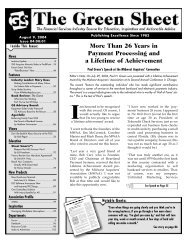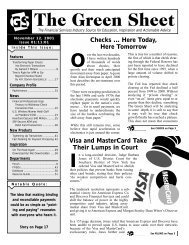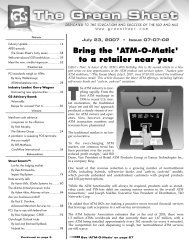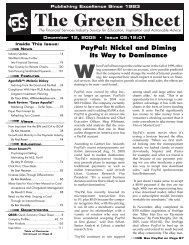View PDF of this issue - The Green Sheet
View PDF of this issue - The Green Sheet
View PDF of this issue - The Green Sheet
You also want an ePaper? Increase the reach of your titles
YUMPU automatically turns print PDFs into web optimized ePapers that Google loves.
78<br />
By Biff Matthews<br />
CardWare International<br />
Optimal sales performance requires a system.<br />
Numerous sales systems are available<br />
– no need to elaborate here. If you, as a<br />
merchant level salesperson (MLS), have not<br />
received a sales system from your up-line, scout for a<br />
system that reflects your personal and pr<strong>of</strong>essional presentation<br />
style.<br />
As <strong>of</strong> <strong>this</strong> writing, Google had 23.4 million matches for the<br />
phrase "sales system" and nearly three times that many<br />
for "selling system." Something on the first or second page<br />
<strong>of</strong> results from such a search will likely fit your needs.<br />
A sales system begins with a numbers game (fill in your<br />
own number for each X): targeting X dollars and X closes<br />
by making X presentations as a result <strong>of</strong> X appointments,<br />
which requires X phone calls from X number <strong>of</strong> leads.<br />
If your up-line is doing its job, it should be providing you<br />
with sufficient leads to allow you to reach your target.<br />
Of course, not everyone you meet is a prospect. And<br />
not all prospects can become good customers.<br />
Sometimes there's just not a good fit in terms <strong>of</strong> your<br />
solutions and a given prospect's situation. That's where<br />
proper qualification comes in. It should be the first step in<br />
your sales process.<br />
Become a detective<br />
Qualification means determining whether you want to do<br />
business with a particular company or individual. A good<br />
system leads to sound decisions about whether your products<br />
and services are the right fit for a given prospect.<br />
A good sales process also always contains well-defined<br />
benchmarks. It could have five, seven or nine steps, each<br />
<strong>of</strong> which requires a pause, a quick synopsis <strong>of</strong> where<br />
everyone is in the discussion and a determination about<br />
whether all parties want to advance to the next step.<br />
Each benchmark produces, in essence, a yes or no conclusion<br />
about whether you and your prospect are aligned. If<br />
no is the answer, the merchant likely already has updated<br />
or new equipment, excellent service and a competitive<br />
rate. <strong>The</strong> idea is to uncover pain and problems, but not<br />
everyone is beleaguered at any given moment.<br />
<strong>The</strong> frequency with which you end up with prospects<br />
who are delighted with the status quo depends on how<br />
your appointments are made. If you encounter <strong>this</strong> situation<br />
<strong>of</strong>ten, greater emphasis on prequalification is clearly<br />
in order.<br />
Education (continued)<br />
<strong>The</strong> beauty <strong>of</strong> systematic sales<br />
An effective MLS is as much detective as salesperson,<br />
tasked with uncovering problems prospects don't even<br />
realize they have. Probative questions should lead to revelations,<br />
including, for example:<br />
• I didn't know <strong>this</strong> equipment could do checks<br />
• I didn't realize that auto settle at night could be<br />
included<br />
• Wow, <strong>this</strong> equipment would really authorize or guarantee<br />
checks?<br />
This approach demonstrates pain through education, and<br />
it's a potential gold mine for creative MLSs.<br />
So, follow the process; get those yeses; make the sales.<br />
But never forget to embrace no, because it uncovers<br />
hidden agendas and, more importantly, true pain. No<br />
is a word to be loved; it's a calibrator. Both yes and no<br />
are qualifiers that provide valuable intelligence about<br />
your prospects.<br />
Find your inner guru<br />
<strong>The</strong> key is to be a good interviewer, one who asks the<br />
questions that lead to logical conclusions through a<br />
prospect's own answers. If <strong>this</strong> is beginning to sound a<br />
little like Dale Carnegie Training, so be it. I believe there<br />
is much to be learned from that organization (which Dale<br />
Carnegie founded in 1912).<br />
Carnegie's speaking class is <strong>of</strong> particular value because it<br />
explores tonal qualities and body language. People absorb<br />
new information differently.<br />
Some do it visually, others learn by hearing or reading<br />
– or a combination. Tuning in to the nuances <strong>of</strong> prospects'<br />
responses will help you speak your customers' language<br />
– in more ways than one.<br />
A widely distributed cartoon (and the inspiration for<br />
a paperback book, I discovered recently) says the sale<br />
begins when the customer says no. I agree, though with<br />
qualification. <strong>The</strong>re are fine lines between, "No, I do not<br />
agree with that," "No, you have not made your point" and<br />
"No, I need to end <strong>this</strong> conversation." Understanding the<br />
differences is critical, but three noes <strong>of</strong> any variety mean<br />
you are out.<br />
At the third no, understand that it's over. <strong>The</strong> fat lady is<br />
singing. Ask for a referral, and do the wrap. That is the<br />
conventional wisdom, and it is valid.<br />
Stick with the plan<br />
<strong>The</strong> leading sales systems in place today have been honed
















